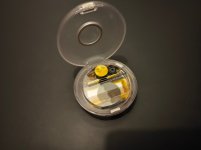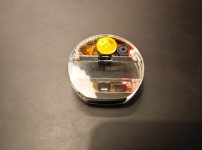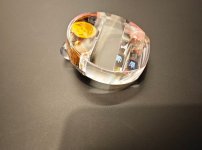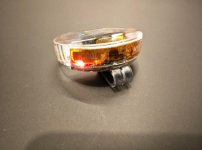Monocle Open-Source Augmented Reality Glasses Hands-On Impressions
A few weeks ago, I had the chance to meet Benjamin Heald, co-founder and head of design at Brilliant Labs, the company behind the open-source augmented reality device Monocle and try their first product. While the startup faces considerable competition in this space with the likes of Apple, Meta as well as other startups like XREAL, Brilliant Labs differentiates itself by having adopted a tinkerer-friendly approach to its first device. It has just launched a Product Hunt page as well as a dedicated arGPT app on the Apple App Store; and is already available to purchase on the official Brilliant Labs website for $349.
In many ways, it reminded me of the Pebble, or as Ben called it, the Raspberry Pi of AR. We’ll see the reasons behind these comparisons later in this article, so let’s take a closer look.
Fashion from the 1800s with a sci-fi twist
I don’t think I’ve ever seen anyone wear a monocle but I sure would wear the Monocle. While these eponymous eyewear went out of fashion since their peak during the 1800s, the Monocle from Brilliant Labs might work as a sci-fi movie prop or a cosmetic item in Cyberpunk 2077’s upcoming DLC; but one that’s fully functional in real-life to provide digital content that superimposes on the physical world.
These AR glasses feature a clip at the back to mount on your existing glasses. It’s simple and wireless, making it easy to wear and take off when you need to. They’ll especially fit round-shaped glasses like mine, but can be accommodated on practically any glasses.
While definitely unique in looks, especially compared to other consumer AR devices on the market that adopt a sunglasses aesthetic, the design choice for the Monocle, Ben says, was influenced by financial as well as technical reasons. Complexities arise in having two smart lenses and, in tandem, costs increase. To keep it more affordable for consumers, Brilliant Labs settled on the single lens design.
This doesn’t mean it was easy to design the Monocle as it packs quite a few components in its circular, 9mm thick form factor. There is a touch panel (with two inputs), a 5MP camera, a microphone, a microOLED display, a Bluetooth module and a FPGA chip.
I’m particularly fond of the transparent shell that displays the Monocle’s innards in all of its glory. Clear shell designs have experienced somewhat of a resurgence lately and I’m here for it.
A potential aspect of the Monocle that could raise some concerns is its front-facing camera. One of the reasons for the Google Glass’ lack of adoption was its intrusive aspect, even earning wearers the moniker of “glasshole”. Brilliant Labs is always considering such concerns, Ben told me; and discussions around this were central to the design of the Monocle. But the company’s co-founder believes that since 2012’s Google Glass, society has evolved to become more accepting towards cameras being everywhere in public. Indeed, during my recent summer travels, random people, as well as myself, would take pictures of sceneries and monuments with passers-by not minding being photographed or recorded on video. Of course there will be some people minding this but the majority might be more intrigued by someone wearing a monocle than finding a camera on a pair of glasses.
One hiccup with the unibody design is that it is hard to disassemble and replace components such as the battery. While Brilliant Labs focused on having the device’s software open source and has also open sourced the hardware schematics, it would have been welcome to have the device more easy to take apart considering its hacker-friendly nature. This might be an avenue for the company to consider with future iterations.
While the hardware schematics are open source, users cannot reproduce the board. But they can still tune the hardware, for example by swapping the camera module for an IMU (inertial measurement unit).
A minor downside on the hardware front for me was that my own glasses were a bit too tall, causing the Monocle’s display to appear lower than it was meant to be. I could eventually see the display well but maybe having clips of different lengths (or having a telescopic one) could have addressed this issue. That said, solutions from the community to help users with similar issues could be an option down the line.
Overall, even after the little time I spent with the Monocle, I was left positively impressed by Brilliant Lab’s first product. It’s sleek, pocketable, packs a unique look and serves as a module to your existing glasses (including sunglasses if you don’t wear glasses).
Hardware is half of the battle
While the hardware left me impressed, the real potential for adoption will ultimately reside on the device’s software library. This is a point I make with every smart glasses I’ve reviewed; as many have impressive hardware but limited software to encourage adoption. The Monocle is no exception. Currently, it has one first-party software, arGPT, available on iOS and coming soon to Android. It’s basically a ChatGPT-powered assistant where you can ask questions that are picked up by the Monocle’s microphone, converted to text and fed to the software. The latter’s response is then beamed to the display in AR mode.
There is some latency to receiving answers but this is being ironed out for future updates, Ben told me. That said, it offers a hands-free way to get answers from ChatGPT in a heads-up fashion from a device you can easily wear and remove at your convenience.
Of note, the AR display is static and does not feature 3DoF. The latter is a more convincing AR experience as I’ve highlighted in my previous coverage of AR devices but I actually didn’t mind the static overlay of the Monocle. This is because of its specific use case for quick queries and text reading where you don’t have to wear the device for long. In fact, it feels more like a device you pop on and off your glasses based on when you need it, rather than an all-day eyewear that other companies are aiming for.
As arGPT is the only first-party app, it can feel quite limiting but the Monocle should be considered more akin to a dev kit than a retail product; even if it is available to purchase now. It’s akin to the Watchy open-source smartwatch in this regard. But the open source aspect of the Monocle is drawing some attention. Its official Discord channel is already 2000 members-strong, developing custom apps of their own and sharing with the community. This indicates potential for the device to develop a software ecosystem more organically by its adopters, which is unlike what others have to offer.
Ben mentioned that Brilliant Labs is looking to develop more apps for the Monocle, and he’s particularly interested in seeing games on it. While not in development, he thinks that location-based games using the device’s camera could be an option, as well as educational information by scanning items.
One concept we further discussed was that of having walkthroughs/solutions for games by having the camera scan and identify the game/puzzle which could be quite neat in a heads-up display fashion. IGN even recently revealed its AI-powered IGN Guides Chatbot which could be an approach adopted by AR glasses for gaming purposes. Given the Monocle’s open-source nature, such ideas could be picked up by the community and developed upon.
The Pebble of AR devices
While Eric Migicovsky, co-founder of Pebble, supported Brilliant Lab’s recent round of funding, this is not the reason why I compare the Monocle to the Pebble. The reason has to do with its tinkerer-focused, open-source nature that is channelling a similar energy to that of the Pebble. The company’s smartwatches amassed a loyal user base that provided continued support for Pebble smartwatches even after official support ended. The Monocle isn’t there but with its hacker-friendly focus, this might be what their future looks like. Benjamin Heald says that’s indeed their focus beyond their first product as well: consumer-oriented but also hacker-friendly.
Indeed, Brilliant Labs is already considering its next product, which they will share more about in the coming months, still with an inclination towards developers and early adopters. I hope that they will also lean towards having the hardware hackable and open source, as opposed to only the software, and also keep in mind the need for lens inserts by some users.
Their trajectory is surely unlike others on the market and this can be their edge. If you’re looking to develop AR software or get started with it, then the Monocle is a great place to start. It’s a well-designed, ready to use and program-for device that costs $349. However, it must be considered first and foremost as a dev kit of sorts, and not as a retail product with a strong library (or even a handful of ready to use apps). For such needs, you could consider alternatives like the INMO Air 2 or the XREAL Air+Beam combo.













